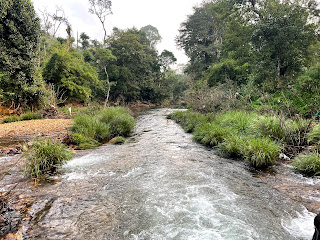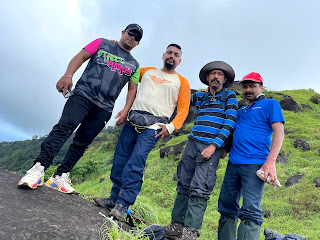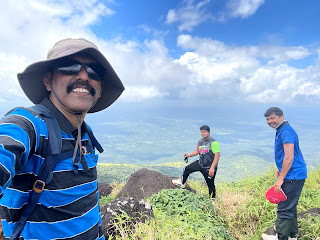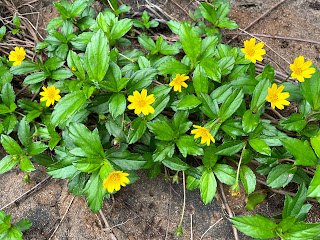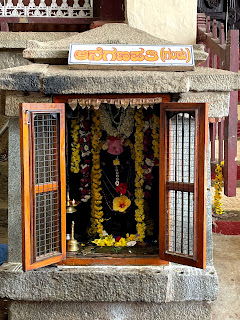I go to nature to be soothed and healed, and to have my senses put in order. —John Burroughs
In my last blog about Rupin pass trek, I had mentioned that just a week before going for the Himalaya hike I had done a trek at Kurinjal in the western ghats. I couldn’t write it before, hence trying to pen the memories now.
Our last trek was to Narasimha Parvata near Agumbe during December 2020. With the pandemic not relenting, planning for more treks was difficult. Hari meanwhile did few treks in small groups with Yatish and friends even during the monsoon. I couldn’t join as I was busy in work and home fronts. Yatish checked about my availability for the weekend of September 25-26. I was trying hard to find a Himalayan trek slot for the Chinese National holidays starting from the 1st October and thought it will be a good preparation to go for a hike one week before. Hari had floated the idea in the larger group, but there were no enthusiasts. It was decided that 5 of us will go to Kurinjal near Kuduremukha. A WhatsApp group with five of us: Hari, Yatish, Vinayak, Pradeep and I, was formed. Yatish wanted us to go early on Friday in order to cover some places on the way. After some discussion we decided to leave around 11:00. Unfortunately, in the last moment Vinayak pulled out as his mother wasn’t well. Thus, we were only four of us. The vehicle was Innova with Siddhesh as the driver. Even though it was close to October, the monsoon wasn’t relenting, and the leech proof socks were a part of our luggage.
It was almost 12 noon be the time I was picked up at the Laggere bridge and the journey was smooth. We stopped for lunch on the way near Hassan around 13:00. The drive was scenic. It was 19:10 by the time we reached the Nelli Gudda home stay at Samse near Kalasa in Chikmagalur district. To reach the home stay, one has to cross either a hanging bridge or walk through shallow flowing river. As it was already dark, we didn’t try the bridge. We had early dinner and rested. The homestay had a central house where Siddhesh slept, and we stayed in an adjacent building that had two beds. The home stay in close to the state highway 66 opposite to the Samse Ganapati temple. Information about Nelli Gudda home stay is available online.
Kurinjal peak is at an altitude of 5,751 ft (1159 M) above the sea level in the Kuduremukh national park range. The base is same for Kuduremukh, Kurinjal and Gangadikal peaks. The trail starts from close the forest office, near the Bhagavathi Herbal camp and the Jungle lodges. Though there are several boards indicating different prices, the revised tariff is Rs. 475/- per person, parking is Rs 50/- and guide fee is Rs. 1000/- per group (of less than 8 people). The name Kurinjal seems to have come from the blue kuranji flowers that bloom on the hills. It was still not the season when we visited.
Next morning, we got up at 6:00, had early breakfast, packed our lunch and left the home stay at 7. We went to the Kuduremukh forest office by our car. We got to pay the fees around 8:30 and went ahead with our guide.
 |
| In front of the home stay |
 |
| Samse ganapati temple |
 |
| Samse town |
 |
| Water source |
The trail was very scenic with lush green
forests, grass lands and streams. While it was generally easy, some places had
steep climbs. As we were in small group of only five people, we climbed
briskly. There was a view point on the way close to the peak. The Kurinjal peak
was picturesque, and the final stretch was quite steep. The trek one way was 7
kms and we were on the peak by 11:30, in about 2 hours! The view all around was
beautiful with several shades of green. We spent about an hour enjoying the
beauty of nature and started coming down by 12:30. We stopped near a stream and
enjoyed the packed lunch. As the dark clouds were gathering, we decided to come
down. While coming down, we faced some rain. We took out the raincoats/ponchos
that we had carried and protected ourselves.
 |
| First view of Kurinjal peak |
 |
| On top of the Kurinjal peak |
After coming down, we met Siddhesh near the
Bhadra river bridge and proceeded to elaneeru (tender coconut) teertha, a
waterfall nearby. The access to the falls is not easy and there are some people
charging money (Rs 50/- per head) for showing you the falls. As the road in not
easy, they also ferry people in their jeep for Es 500/- a trip. I feel the
government can work on the access and make it into a systematic tourist place.
I repeat here that if we do our tourism properly, India can be the richest
country in the world. Hope the government considers it.
 |
| Elaneeru teertha |
As I had already taken off my shoes and
changed into the slippers, the steep, slippery accent was difficult. Once we
reached the falls, the view was spectacular. It was a very high falls falling
at an amazing speed. The falls also cascades into different levels making the
whole fall marvelous. While Yati and Pradeep stayed below the falls for long, I
and Hari quickly came down. There, next to the rough road one can see another
portion of the falls where Yati and Pradeep again spent time. As it was already
close to 18:00 and was getting dark, we returned to the home stay. That evening
we had a good time with campfire and singing. Next morning, we checked out and
went to the Samse Ganapati temple. The temple was closed, but many people were
going photo shoot at the tea gardens. We also spent some time there and then
went to Kalasa where we visited the Kalaseshwara temple. There is a
much-revered place on the banks of Bhadra river also known as Dakhina Kashi.
According to legends, two devotees Mitra and Varuna were in tapa, deep penance.
Devendra as usual, was afraid of this tapa and sent Urvashi, an apsara to spoil
the penance. Mitra and Varuna were attracted by the apsara and danced with her.
As a result of their union with Urvashi,
Agastya was born in a pot ‘kumbha’ or
‘kalasa”. Agastya then went on to
become one of the most famous rishis who along with his wife Lopamudra has a
great place in vaidik itihasa and puranas. He is said to have worshipped Shiva
in this place and it is believed that lord Shiva appeared before him and his part
remained here as Kalaseshawara.
 |
| Hanging bridge to homestay |
 |
| At Sri Annapoorneshwari temple, Horanadu |
 |
| Amba teertha |
The temple has stone carvings and shasanas (inscription stones). One more unique feature is the presence of male and female “Ane Ganapati”s.
After the temple, we visited Amba teertha. While we could have driven close to the river, someone misguide us saying that vehicle won’t go. Thus we had to walk a long way. Later we realized that there were vehicles close to the river already. Amba teertha is one of the five holi water spots of Kalasa (the others being Vasistha Theertha, Naga Theertha, Naga Koti Theertha and Rudra Theertha). The site is very scenic with river Bhadra in full flow, several whirlpools and the rocks carved into different shapes by the flowing river. It is believed that this is the place where Draupadi received the Akshaya patra. It is also said that Maharishi Vashista is supposed to have performed his penance here. There is a small temple for him here. Nearby, there is an impressive hanging bridge across the river.
 |
| At Kalasheshwara Temple |
Our next stop was the famed Annaporneshwari temple at Horanadu. We were there by 13:00, did the darshan and proceeded for the temple lunch. Due to covid, now devotees must pick the plates from a place, get served at a counter and wash and leave the plates. The prasada lunch, still was very divine. We left the temple around 14:00, had dinner at a place called “ole oota” where we tried the biriyani cooked in bamboo and ragi balls. After getting down at Laggere bridge, it took me some time to get the auto and I reached home by 21:30. During the trip I caught a bad cold that troubled me during the next trek to Rupin pass.
Kurinjal trek was a great experience in
terms of being in the nature. The place will be etched in my memory for long.
Thanks to my friends for organizing this beautiful trek.



